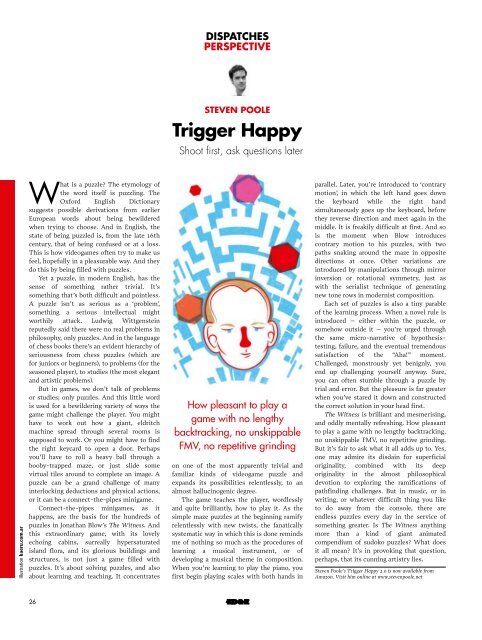Create successful ePaper yourself
Turn your PDF publications into a flip-book with our unique Google optimized e-Paper software.
Dispatches<br />
perspective<br />
steven poole<br />
trigger happy<br />
Shoot first, ask questions later<br />
Illustration kaeru.com.ar<br />
W<br />
hat is a puzzle? The etymology of<br />
the word itself is puzzling. The<br />
Oxford English Dictionary<br />
suggests possible derivations from earlier<br />
European words about being bewildered<br />
when trying to choose. And in English, the<br />
state of being puzzled is, from the late 16th<br />
century, that of being confused or at a loss.<br />
This is how videogames often try to make us<br />
feel, hopefully in a pleasurable way. And they<br />
do this by being filled with puzzles.<br />
Yet a puzzle, in modern English, has the<br />
sense of something rather trivial. It’s<br />
something that’s both difficult and pointless.<br />
A puzzle isn’t as serious as a ‘problem’,<br />
something a serious intellectual might<br />
worthily attack. Ludwig Wittgenstein<br />
reputedly said there were no real problems in<br />
philosophy, only puzzles. And in the language<br />
of chess books there’s an evident hierarchy of<br />
seriousness from chess puzzles (which are<br />
for juniors or beginners), to problems (for the<br />
seasoned player), to studies (the most elegant<br />
and artistic problems).<br />
But in games, we don’t talk of problems<br />
or studies; only puzzles. And this little word<br />
is used for a bewildering variety of ways the<br />
game might challenge the player. You might<br />
have to work out how a giant, eldritch<br />
machine spread through several rooms is<br />
supposed to work. Or you might have to find<br />
the right keycard to open a door. Perhaps<br />
you’ll have to roll a heavy ball through a<br />
booby-trapped maze, or just slide some<br />
virtual tiles around to complete an image. A<br />
puzzle can be a grand challenge of many<br />
interlocking deductions and physical actions,<br />
or it can be a connect-the-pipes minigame.<br />
Connect-the-pipes minigames, as it<br />
happens, are the basis for the hundreds of<br />
puzzles in Jonathan Blow’s The Witness. And<br />
this extraordinary game, with its lovely<br />
echoing cabins, surreally hypersaturated<br />
island flora, and its glorious buildings and<br />
structures, is not just a game filled with<br />
puzzles. It’s about solving puzzles, and also<br />
about learning and teaching. It concentrates<br />
How pleasant to play a<br />
game with no lengthy<br />
backtracking, no unskippable<br />
FMV, no repetitive grinding<br />
on one of the most apparently trivial and<br />
familiar kinds of videogame puzzle and<br />
expands its possibilities relentlessly, to an<br />
almost hallucinogenic degree.<br />
The game teaches the player, wordlessly<br />
and quite brilliantly, how to play it. As the<br />
simple maze puzzles at the beginning ramify<br />
relentlessly with new twists, the fanatically<br />
systematic way in which this is done reminds<br />
me of nothing so much as the procedures of<br />
learning a musical instrument, or of<br />
developing a musical theme in composition.<br />
When you’re learning to play the piano, you<br />
first begin playing scales with both hands in<br />
parallel. Later, you’re introduced to ‘contrary<br />
motion’, in which the left hand goes down<br />
the keyboard while the right hand<br />
simultaneously goes up the keyboard, before<br />
they reverse direction and meet again in the<br />
middle. It is freakily difficult at first. And so<br />
is the moment when Blow introduces<br />
contrary motion to his puzzles, with two<br />
paths snaking around the maze in opposite<br />
directions at once. Other variations are<br />
introduced by manipulations through mirror<br />
inversion or rotational symmetry, just as<br />
with the serialist technique of generating<br />
new tone rows in modernist composition.<br />
Each set of puzzles is also a tiny parable<br />
of the learning process. When a novel rule is<br />
introduced – either within the puzzle, or<br />
somehow outside it – you’re urged through<br />
the same micro-narrative of hypothesistesting,<br />
failure, and the eventual tremendous<br />
satisfaction of the “Aha!” moment.<br />
Challenged, monstrously yet benignly, you<br />
end up challenging yourself anyway. Sure,<br />
you can often stumble through a puzzle by<br />
trial and error. But the pleasure is far greater<br />
when you’ve stared it down and constructed<br />
the correct solution in your head first.<br />
The Witness is brilliant and mesmerising,<br />
and oddly mentally refreshing. How pleasant<br />
to play a game with no lengthy backtracking,<br />
no unskippable FMV, no repetitive grinding.<br />
But it’s fair to ask what it all adds up to. Yes,<br />
one may admire its disdain for superficial<br />
originality, combined with its deep<br />
originality in the almost philosophical<br />
devotion to exploring the ramifications of<br />
pathfinding challenges. But in music, or in<br />
writing, or whatever difficult thing you like<br />
to do away from the console, there are<br />
endless puzzles every day in the service of<br />
something greater. Is The Witness anything<br />
more than a kind of giant animated<br />
compendium of sudoko puzzles? What does<br />
it all mean? It’s in provoking that question,<br />
perhaps, that its cunning artistry lies.<br />
Steven Poole’s Trigger Happy 2.o is now available from<br />
Amazon. Visit him online at www.stevenpoole.net<br />
26




